



Manisha Singhal shifted to Prabhadevi in the Central part of the city from Parel, another location in Central Mumbai last year. Unlike most relocations, her move was necessitated by her need for open spaces and a bigger balcony after two waves of COVID-19, and having to stay at home for extended periods. And in a famously land-starved metropolis like the financial capital, where every square inch is worth a small fortune, leaving space unoccupied, like in the case of balconies, is considered a colossal waste.
Of course, hers is an atypical case. The family shifted to Mumbai from Delhi 15 years ago and were surprised to see the tiny balconies in Mumbai, not to mention apartments that didn’t have any. But there are scores of others who have had enough of being confined to small flats with no open spaces to step out into, and the real estate industry is taking note.
 Picture credits: Manisha SinghalAre home buyers paying more for a balcony?
Picture credits: Manisha SinghalAre home buyers paying more for a balcony?Sanjay Sippy, real estate consultant of Sippy Housing who operates in the luxury markets of Bandra, Khar and Santacruz in suburban Mumbai, said that having balconies can definitely fetch a particular developer a higher price. He said, “A balcony has a selling point, and one can surely have a buffer while negotiating the price with customers for a balcony. In Mumbai, for example if a balcony is 40 sq ft, and the rate in Bandra area is Rs 50,000 per sq ft, that means the value of that balcony is around Rs 20 lakh. Hence, it is obvious that something worth Rs 20 lakh will give some return to the developer who is accommodating it in their design, and this also means that citizens do not mind paying more for it considering it will give equal return during resale.”
Have balconies made a comeback in Mumbai?So, does this indicate that balconies have made a comeback in the Mumbai residential market? Real estate developers, architects and brokers Moneycontrol spoke to said as COVID-19 hit the country and the city restricting movement of people, the demand or preference for purchasing or renting an apartment in Mumbai with a balcony, where one can literally have some breathing space, has gone up.
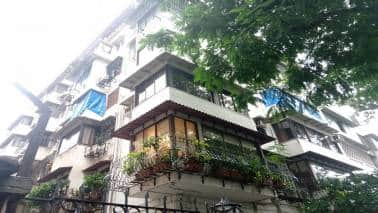 A picture of a building with balcony on A Road of Marine Drive area in Mumbai. (Picture credits: Mehul R Thakkar)History of balconies in Mumbai apartments
A picture of a building with balcony on A Road of Marine Drive area in Mumbai. (Picture credits: Mehul R Thakkar)History of balconies in Mumbai apartmentsIt is not that flats in the city do not have step-out areas. The history of balconies in Mumbai’s apartments that are often described as matchbox-sized flats goes back to the 1960s. New projects offering balconies in each apartment was a common feature till the late 1990s. Since then, however, only premium apartments ranging from 3BHK or 4 BHK came with this amenity. A big reason for these little alcoves disappearing was also that the size of 1BHK and 2BHK apartments shrank below 700 sq ft amid rising property rates, leaving no room at all for ‘extras’ like a sit-out.
“In Mumbai, before 1960s, the British era pagdi system (a tenancy model where the ownership partially lies with the landlord of the property) was much in existence, and it was by the 1960s that the trend of flat ownership picked up with the landmark law (the Maharashtra Ownership Flats (Regulations of the Promotion of Construction, Sale, Management and Transfer) Act, 1963) coming into force. Several areas like Bandra, Khar and Juhu that earlier had bungalows that later were turned into multi-storeyed buildings and the ownership of flat or apartments was very much evident by the late 1960s. With this, balconies in those days were also offered, and it continued till the late 1990s,” said Vilas Nagalkar, an architect based in Mumbai.
Nagalkar added, “Later, from 2000, a lot changed in the real estate market of Mumbai and many new players entered the real residential segment. They started offering something like a flower bed or lily pool, lily pond, etc., but this did not last for long. The Mumbai civic body restricted all such practices and by 2012, balconies that were earlier not counted in FSI (floor space index, the ratio of floor area to the total area of the plot), were now being counted in the FSI. This meant that when developers gave balconies, it ate into their FSI. Later, French windows came into picture but it could never match the charm of a balcony, at most French windows with half grills remained just superficial replicas of balconies.”
He added, “However, now it seems post-COVID-19, citizens have understood the importance of having open space within the four walls, and hence there is a demand for balconies even for 2BHK apartments. But, this does not mean that every building in Mumbai will start having balconies. On the west, there is the Arabian Sea, and it makes sense to have balconies if there is sea view. In the western suburbs, towards the east there is the Sanjay Gandhi National Park, and it further makes sense to have a balcony if there is a forest view, but if there is say another building 6 metres away, a balcony might not make sense.”
Reza Kabul of ARK Reza Kabul Architects, during a July 1 panel discussion organised by NAREDCO NEXTGEN, the youth wing of the National Real Estate Development Council (NAREDCO), an industry body, said, “Post-COVID we are witnessing increased demand of homebuyers insisting on homes having balconies as break-out spaces. In pre-COVID times, the balcony had vanished to increase the size of the apartment. This new insistence has resulted in developers introducing the balcony back into the apartment. Further increasing the demand for larger apartments as space became a necessity and not a luxury. Further, there is increasing demand for larger apartments as space becomes a necessity and not a luxury.”
Speaking to Moneycontrol, Kabul said, “Another angle that arose from COVID was the introduction of the home office as videoconferencing and work from home became the need of the hour as the family wanted their privacy and so did the bread earner. Further, the kids attended online school, hence giving rise to the home office. We started introducing cubicles in the common areas so that VCs (videoconferences) could be attended without disturbing the families.”
He added, “Even lounges were introduced in common areas to avoid taking the guest to homes to keep the virus out. Buyers who wished to purchase a 1BHK started stretching their budget to 2BHK as they started feeling the importance of larger spaces.”
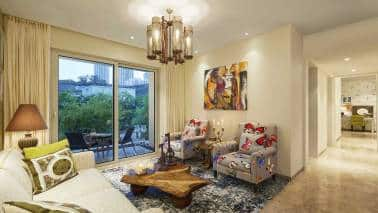 Representational image of apartment with balcony. (Picture credits: Hiranandani Developers)Have seen balconies vanish in front of my eyes
Representational image of apartment with balcony. (Picture credits: Hiranandani Developers)Have seen balconies vanish in front of my eyesWhile by the late 1990s developers stopped giving much importance to balconies in their designs, several of those residing in buildings constructed between the 1960s and the 1980s ended up enclosing their balconies. This was because with the increase in the number of family members in the house, there was a need for more space. So several residents repurposed the open areas into kitchens, spare bedrooms, studies, and the like.
The practice was so rampant that the Brihanmumbai Municipal Corporation (BMC) declared four years ago that it would not regularise structures where balconies have been enclosed. Despite this, however, one can still find balconies of several old buildings on Marine Drive, Grant Road and several areas in the suburbs being enclosed.
 In the picture a housing society can be seen whose resident seem to have enclosed their balconies. (Picture credits: Naresh Kapur)
In the picture a housing society can be seen whose resident seem to have enclosed their balconies. (Picture credits: Naresh Kapur)Naresh Kapur, a 60-year-old who has been residing on Marine Drive for over 50 years now, says he has seen balconies disappearing from Mumbai’s skyline in front of his eyes. “In new buildings, developers do not give balconies as it will reduce the apartment size, and many in our area have enclosed the balconies as their family grew,” he said.
 View from the balcony of Marine Drive resident Naresh Kapur . (Picture credits: Naresh Kapur)
View from the balcony of Marine Drive resident Naresh Kapur . (Picture credits: Naresh Kapur)Kapur, who resides in a 2,700 sq ft sea-view 3BHK apartment on Marine Drive, said, “Those who have enclosed their balconies did regret during the lockdown, but people needed space. Even though we needed space as our family members increased, we never enclosed the balcony. We give special attention to repairing our balcony whenever there is repair work in our building. I cannot imagine my house without a balcony as a balcony for us is not only for the sea view but it has become a part of our lives. We sit there daily, take in some fresh air, and enjoy our sun bath. During the lockdown, we put in a basket with a rope and used to pull up our parcels. The balcony has helped us a lot during the lockdown, and ultimately we have to decide four ourselves.”
Balcony helped us survive lockdownMahendra Hemdev, another resident of Marine Drive, said, “We have a 3BHK of 1,500 sq ft on D Road and we have a balcony that is connected to the two bedrooms and dining room. The balcony in our house has become a part of our daily routine where we go daily in the morning, have our tea and read newspapers. It is very pleasant to sit out especially during the monsoon, and it has a benefit of cross ventilation; that is one of the reasons why we have not enclosed our balcony. We like the old charm and it has helped us tremendously during the COVID lockdown. In the future, whenever our building goes for redevelopment, we would prefer a balcony.”
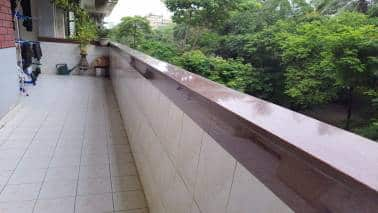 View from the balcony of Mahendra Hemdev. (Picture credits: Mahendra Hemdev)
View from the balcony of Mahendra Hemdev. (Picture credits: Mahendra Hemdev)Another Mumbai resident, Tanushree Venkatraman, said the balcony was one of the highlights in their 3BHK apartment that they purchased in 2013.
She said “My two-and-a-half-year-old son had so much space to run around and play throughout the two years of COVID-19 lockdown. A balcony nowadays has become a luxury, but it is a good place for me to just take a break from work and not look at screens all the time. In my parent’s apartment at Sion (in Central Mumbai), we have now made the balcony accessible; it was earlier blocked by grills. Also, now that we have kids in the house, it is wonderful to watch the sunset from our apartment there.”
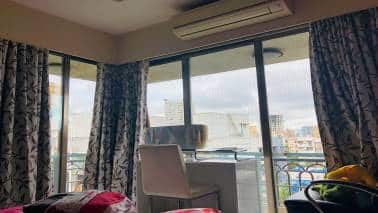 Tanushre says she intends to increase plantation in the balcony of her 3 BHK apartment in Mulund. (Picture credits: Tanushree Venkatraman)Why did balconies go missing in Mumbai?
Tanushre says she intends to increase plantation in the balcony of her 3 BHK apartment in Mulund. (Picture credits: Tanushree Venkatraman)Why did balconies go missing in Mumbai?There are several reasons behind why the balconies go missing from the Mumbai apartments and these include rising prices, changing regulations and the changing dynamics in the Mumbai Real Estate Market.
A city-based architect said on condition of anonymity, “Earlier, traditionally Sindhis, Punjabis and Gujaratis up to an extent dominated the real estate market in Mumbai, but later several other communities came into the business. With this several other amenities came in like a worship place in premises of the building, swimming pool, club house, gym, etc., which in a way compensated for the balconies.”
Changing regulations for FSI are also responsible. The FSI determines how tall a building can be. In 2012, the BMC brought balconies into the ambit of fungibility of FSI. Prior to this, balconies were not taken into account when calculating the FSI. But there was practice of developers charging extra for the balcony, and hence the BMC decided to include them into FSI and charge a premium for the same from builders.
Despite this, developers continued to offer balconies in the luxury segment, but not in the case of mid-size 1 and 2BHK apartments. Post COVID-19, though it seems like that developers might have to go back to the drawing board when it comes to smaller apartments given the trend.
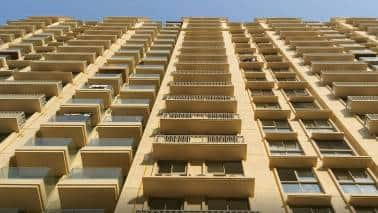 A view of the building constructed by Hiranandani Developers with balcony in Mumbai. (Picture credits: Hiranandani Developers)Has demand gone up post-COVID lockdown?
A view of the building constructed by Hiranandani Developers with balcony in Mumbai. (Picture credits: Hiranandani Developers)Has demand gone up post-COVID lockdown?“The demand for apartments with balconies has been quite prominent. In the last six months, we have seen around 60-65 percent of the total homebuyers on our platform prefer various amenities most of which included balconies or separate smaller space, unlike prior to COVID-19. This demand is prevalent across homes that are more than 600-800 sq ft and this is found the most across 2BHK and above,” said Ashish Narain Agarwal, founder and CEO, PropertyPistol.com, an online real estate firm.
What are developers doing about it?Niranjan Hiranandani, managing director at leading property developer Hiranandani Group, told Moneycontrol, “Balcony homes are in vogue post the COVID pandemic, offering a rejuvenation corner for homebuyers. The need for more open and ventilated space in the house is in demand by the new potential customer cohorts. Demand for such open areas and decks picked up steam post the COVID menace especially in the dense urban cities. This has skewed the customer preferences towards open deck-like balcony spaces which has nudged developers to reinstate such layout design back in trend, even at a premium cost.”
Larger balconies due to higher demandRam Raheja, director at S Raheja Realty, said they have increased the size of balconies as demand has gone up.
He said, “We have always provided balconies even in FSI, and have always encouraged balconies in all our projects in Khar-Bandra-Santacruz. Post-pandemic, we are giving larger balconies as the homeowners want better open spaces within the house and hence the demand for balconies has seen a spike in the micro markets we usually operate. For example, in a 2,000 sq ft apartment, initially we were giving 120 sq ft of balcony but the size has now gone up to 200 sq ft as buyers are seeking the same.”
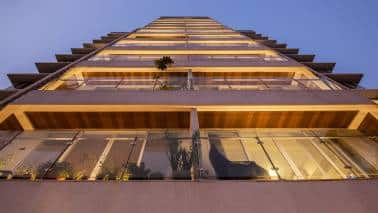 Picture of a building constructed by S Raheja in Mumbai with a balcony. (Picture credits: S Raheja)
Picture of a building constructed by S Raheja in Mumbai with a balcony. (Picture credits: S Raheja)He added, “Earlier, all 2BHKs did not have a balcony, but now homeowners are asking for a balcony. The existing flat owners in a redevelopment project were not always keen on a balcony, but now they are also asking for it. A large balcony in the living rooms, and one in the master bedroom, and a dry balcony in the kitchen is what we are providing in the flats currently.”
Discover the latest Business News, Sensex, and Nifty updates. Obtain Personal Finance insights, tax queries, and expert opinions on Moneycontrol or download the Moneycontrol App to stay updated!
Find the best of Al News in one place, specially curated for you every weekend.
Stay on top of the latest tech trends and biggest startup news.